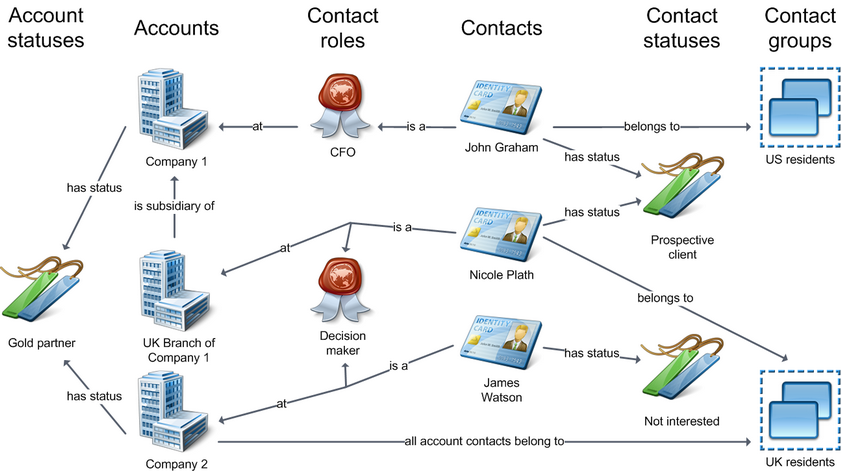Overview |

|

|

|

|
|
Overview |

|

|

|

|
|
|
||
The Contact management module is an on‑line marketing tool which provides a centralized overview of all users who visit your website. It can be used to gather information about them and about the activities that they perform on the website. The data gathered by the module can be used to track campaign results, analyze client behavior, optimize content, identify potential buyers and perform other marketing‑related actions.
To get started with the module, it is important to get familiar with the following basic terms represented by objects of the module. Click the links to learn more about the particular objects, their management, use and configuration.
•Contact - a single person who visits the website and about whom information is gathered by the module.
•Account - a company or other commercial or non‑commercial body where a contact operates. Individual contacts can belong to multiple accounts and an account can be a subsidiary of another account.
•Contact role - the role which a contact has in an account. It is typically a job position or a type of competence which the contact has within the account. One contact can have only one role in one account.
•Contact status - individual contacts can be labeled with pre-defined statuses. One contact can be labeled with only one status at a time.
•Account status - individual accounts can be labeled with pre-defined statuses, similarly as contacts, while there are separate sets of statuses for contacts and accounts. One account can be labeled with only one status at a time.
•Contact group - taxonomy units which enable you to sort contacts into groups. Contacts can be added to groups either manually, or automatically based on dynamically evaluated macro conditions. It is also possible to add an account to a contact group, which makes all contacts belonging to the account belong to the contact group as well.
The sample diagram below depicts how relationships between the objects may look in a real world scenario. It shows three contacts who operate as different roles in three accounts. They are grouped in two contact groups and both contacts and accounts are labeled with statuses.

In certain situations, it may happen that you have multiple contacts or accounts in the system and get to the conclusion that they actually represent one object. In the Merging contacts and accounts sub-chapter, you can learn how to get rid of such duplicate contacts or accounts by merging them into a single object.
Another important part of the Contact management module are Activities. Activities are actions that a contact performs on the website, e.g. visit a page, vote in a poll, add a product to their shopping cart or wishlist, etc. These activities can be tracked and logged so that you can view a log of all activities that individual contacts performed. You can deduce conclusions about the contacts from the activities that they performed and the logged activities can also be used for contact evaluation by the Scoring module.
Near the end of this chapter, you can find the Settings sub-chapter. In it, you can learn how to enable or disable various parts of the module and configure its functionality.
Finally, the Database separation sub-chapter describes how to transfer and host all data related to contact management in a different database than the one used for the main application.